Driving to Vang Vieng on a hot Saturday in the rainy season, there’s nothing quite like the sight of mist curling through the limestone karst formations as you reach the town.
That, alongside the scattered iridescent rice paddies, is what all your visions of rural Laos are made of.
Later, if you’re lucky enough to be staying at the Riverside Boutique Resort just out of the tiny main town, you will gaze out from your balcony into the courtyard, where staff are lifting the protective covers off the cushioned loungers by the sparkling infinity pool. The rain has just stopped, and rolled up towels are being distributed. Shortly, you’ll head down for a dip and a poolside drink.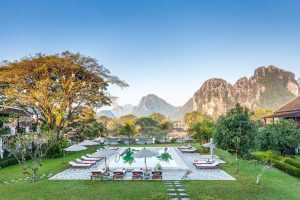
The view, from the balcony and the pool, takes in the Nam Song river, gushing at this time of year, and populated by fishing boats. The limestone looms beyond, and the mist continues to furl.
The scene is set. But this isn’t the infamous Vang Vieng of 10 years ago; traces of that one are still there, beyond the resort and down in the town, one that is still, bafflingly, aimed at the 90s backpacker tourists. The three main streets are potholed and muddied, and many of the restaurants are still – still!- advertising cocktail ‘buckets’. Many have cushioned platforms with low tables, on which you can sprawl and watch Friends on a loop all day long – another baffling long-time tradition. The shops, rows and rows of them, are selling tie-dyed happy pants, fake Crocs and floppy hats. It’s surreal and out of place in such a stunning landscape. And it has long been thus.
But there have been changes in recent years, not least due to the negative media reports about the town’s party reputation and lake of safety regulations. Vang Vieng has long been a magnet for young travellers looking for cheap party towns, and for many years, the narrow streets were filled year-round with European and Australian backpackers. As the years went on, the crowds grew more crass, badly behaved and underdressed. They all but eclipsed the natural beauty of Vang Vieng’s surrounds by turning a better class of tourist away.
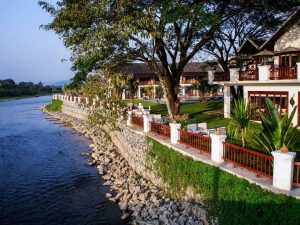
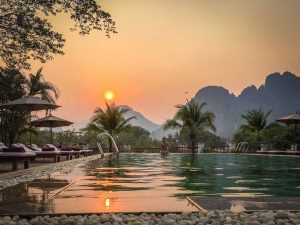
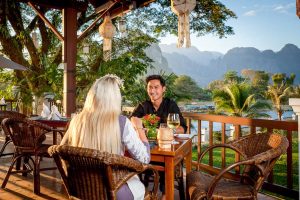
Today, though, the crowds look different. More than 50 per cent of tourists are Asian, and the vast majority of these are Korean. This is largely thanks to a popular Korean reality show, Youth Over Flowers, an episode of which was shot in Vang Vieng and screened at the end of 2014. Korean tourists – well-dressed, well-behaved and earnestly appreciative of their surrounds – have been flocking to the town in large groups ever since.
And there is still plenty on offer for the non-partying crowd, and always has been. Just five minutes out of town and there are picturesque villages, caves, farms and a lagoon to investigate – the real reason why many tourists were attracted to the place in the early days. The Korean groups take it all in almost as a matter of professional obligation, ticking off each activity diligently, and causing delays on the bridge in and out of town with their streams of two-person buggies, another new addition to the town in recent years.
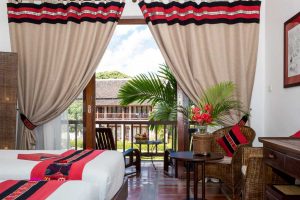

For the Riverside Boutique Resort, this new influx of Korean tourists has meant a steady stream of business, with no low season. In a town choking with low-grade accommodation, the resort has almost no competition, and is not at the mercy of the weather or the seasons. There are almost no vacancies during our weekend visit, and despite almost continuous rain, the hotel restaurant – again, the only eatery of its calibre for miles – is packed with customers.
“It is quite a challenge to run a resort in a place like Vang Vieng, but not because it is so filled with accommodation” says co-owner Stephane Vigie.
“In fact, I think it is easier to run a high-end resort in a town without competitors at this level, than in a place like Luang Prabang filled with luxury hotels.”
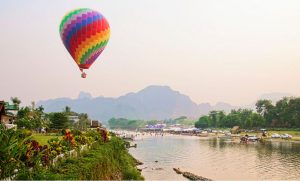
He has high hopes, though, that Vang Vieng will one day meet its tourist potential with a bit more style – starting with better planning and control of the urban and natural environment.
“In the town itself, it will mean cleaning up the place, enforcing minimum quality standards, and opening higher quality bars and restaurants,” he says.
“Outside the town, where the real assets of Vang Vieng lie, it will mean managing and controlling the development of tourist activities so that they do not end up spoiling the environment and what makes Vang Vieng an attractive place.
“At Riverside, we have always tried to set the example and to promote an eco-friendly tourism that places the emphasis on the local cultural heritage but there is only so much we can do alone.”
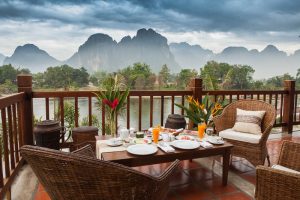 For a resort, the main challenge, he says, is to find, train and retain staff in a town where it is “virtually impossible to find staff with adequate training and prior experience”.
For a resort, the main challenge, he says, is to find, train and retain staff in a town where it is “virtually impossible to find staff with adequate training and prior experience”.
“I think we did a good job meeting this challenge,” he says. And indeed, when met with a random request for white wine by the pool, a young waiter reels off a list of wines on offer without hesitation.
Later, early in the evening, we venture out for a pre-dinner stroll, and find streets clogged with slow-moving tourists of all stripes – well-heeled Westerners and chattering Koreans and Chinese. It’s interesting for about 15 minutes, until we realise there is very little in the way of good-quality food – the psychedelic lighting and scruffy interiors are far from inviting. We beat a retreat back to the resort, where gin and tonics and excellent food are readily available.
The next morning, we have breakfast on the restaurant’s balcony, overlooking the river, the karst and the boats. The town is far behind us. It’s easy to believe, even just for duration of breakfast and until checkout, that it no longer has any need to exist.



 ລາວ
ລາວ
